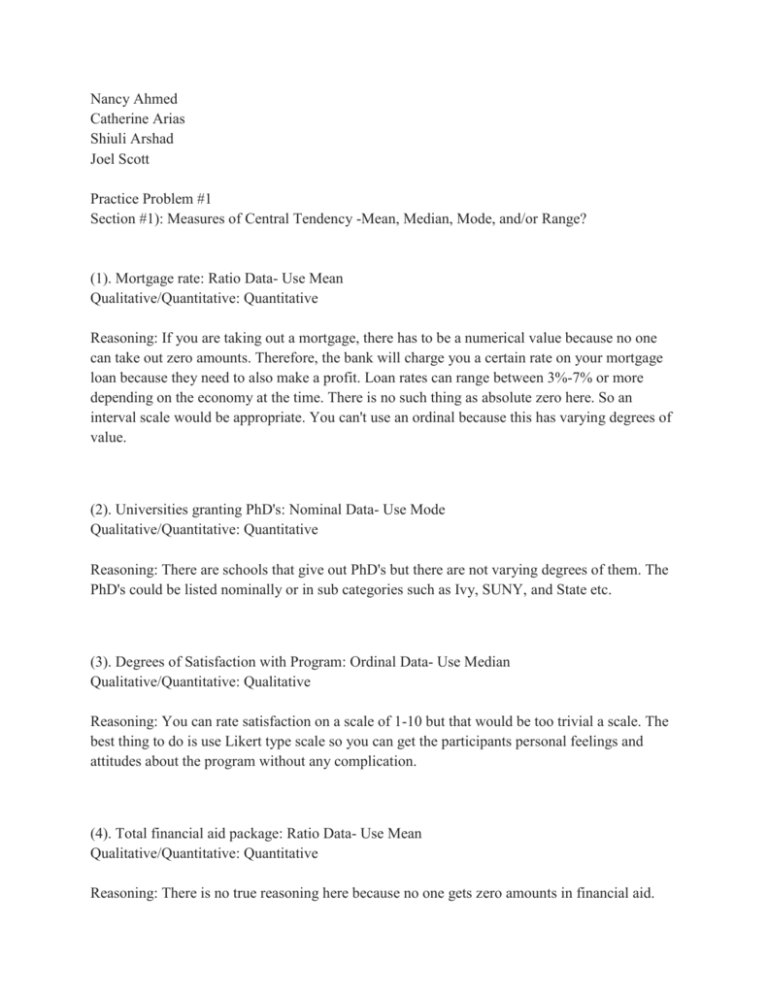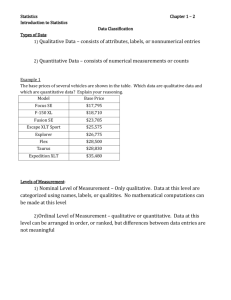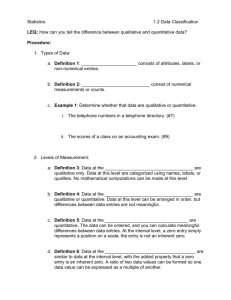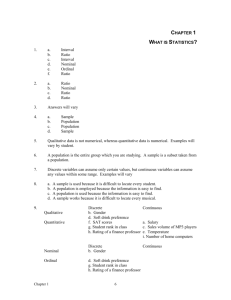NA. CA. JS#1 - ActionResearchProjects
advertisement

Nancy Ahmed Catherine Arias Shiuli Arshad Joel Scott Practice Problem #1 Section #1): Measures of Central Tendency -Mean, Median, Mode, and/or Range? (1). Mortgage rate: Ratio Data- Use Mean Qualitative/Quantitative: Quantitative Reasoning: If you are taking out a mortgage, there has to be a numerical value because no one can take out zero amounts. Therefore, the bank will charge you a certain rate on your mortgage loan because they need to also make a profit. Loan rates can range between 3%-7% or more depending on the economy at the time. There is no such thing as absolute zero here. So an interval scale would be appropriate. You can't use an ordinal because this has varying degrees of value. (2). Universities granting PhD's: Nominal Data- Use Mode Qualitative/Quantitative: Quantitative Reasoning: There are schools that give out PhD's but there are not varying degrees of them. The PhD's could be listed nominally or in sub categories such as Ivy, SUNY, and State etc. (3). Degrees of Satisfaction with Program: Ordinal Data- Use Median Qualitative/Quantitative: Qualitative Reasoning: You can rate satisfaction on a scale of 1-10 but that would be too trivial a scale. The best thing to do is use Likert type scale so you can get the participants personal feelings and attitudes about the program without any complication. (4). Total financial aid package: Ratio Data- Use Mean Qualitative/Quantitative: Quantitative Reasoning: There is no true reasoning here because no one gets zero amounts in financial aid. That would mean they don't need financial aid or did not get anything and we are looking for a total value. The range could be all over the place. For example, students can get financial aid between $500-$20,000. Therefore, interval scale would be appropriate. (5). Hours spent studying: Interval Data- Use Mean Qualitative/Quantitative: Quantitative Reasoning: A person may not study at all so there is a possibility of absolute zero. The number could also reach up to 10 hours or more. A ratio scale categorizes everyone pretty well. Ordinal scale can also be used for this type of data. (6). Birth Order: Ordinal Data- Use Median Qualitative/Quantitative: Quantitative Reasoning: For birth order an interval scale should work here. For example Joel was the first born, Nancy was the second born, Shiuli third and Catherine was the last born. So there is an interval between the ages. A simple scale of interval (or ordinal) works here. Nominal scale can work too if you decide to categorize the birth by names. This has plenty of possibilities. (7). Favorite Musician: Nominal Data- Use Mode Qualitative/Quantitative: Qualitative Reasoning: Since we can't list every single musicians we can however find out a lot by listing a few samples of musicians and putting them in Likert's or percentile ranks. For example musicians like Michael Jackson or Taylor Swift can be measured by ranks 1="not so great", 2="good", 3="great" etc. This type of scale will show one’s personal feelings about the musicians. (8). Number of Siblings: Nominal Data- Use Mode Qualitative/Quantitative: Quantitative Reasoning: Since there is a possibility a person may be an only child there is an absolute zero. This can be easy to categorize and is a physical measure. For example "John" is an only child so he has no siblings. Physically there is a zero in the sibling category. (9). Price of gold shares: Ratio Data- Use Mean Qualitative/Quantitative: Quantitative Reasoning: For price of gold shares there is an absolute zero. This ranges over time and trends. The price of gold is generally related to the value of the U.S dollar. For example if the U.S dollar is strong at the moment then the price of gold is lower which means people tend to trade and invest more with the dollar. If the U.S dollar becomes weak then the price of gold rises and people will invest more on gold. This scale does not involve people's personal opinions or feelings. So interval scale would be appropriate for this. (10). GPA: Ordinal Data- Use Median Qualitative/Quantitative: Quantitative Reasoning: You can have a 0.0 GPA but it caps out at 4.0. So this has a set value cap and would make sense to chart it using a scatter plot on a ratio scale. In the scatter plot you can order the GPA's from 0-4.0.







